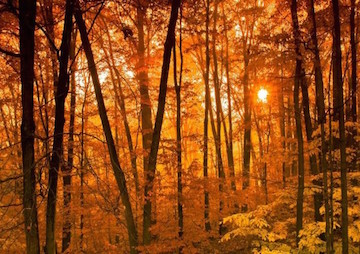Heat Saps Trees’ Beneficial Effect
As the planet continues to warm, forest restoration may not be as efficient a strategy as thought for countering increased carbon dioxide in the atmosphere.
By Tim Radford / Climate News Network

Rising temperatures mean foliage faces challenges other than absorbing carbon. (slack12 via Flickr)
This Creative Commons-licensed piece first appeared at Climate News Network.
PARIS — The vegetable world — especially in the form of forests, one of the great counters to climate change — may not be able to keep pace with global warming.
New research suggests that although increasing levels of carbon dioxide in the atmosphere can and do deliver extra fertilisation and more vigorous growth, the effect may have been over-estimated.
And a second study offers a new way of exploring the trade-off between temperature and photosynthesis, the process that converts atmospheric carbon into timber and food on the table.
Plants need carbon dioxide to grow. In the last century, global average levels of carbon dioxide in the atmosphere have risen from fewer than 300 parts per million to 400 parts, as humans burn fossil fuels and put more of the greenhouse gas into the atmosphere. The vegetable world is calculated to absorb at least one-third of these new emissions.
Satellite evidence
But William Kolby Smith, an ecologist at the University of Minnesota, and colleagues report in Nature Climate Change that the foliage may not be able to keep up the good work. And that may be because, as the planet warms, plants face other challenges.
They examined satellite evidence of plant cover over the last 30 years and found that plant growth had indeed increased — but not as much as calculations had predicted. This was perhaps because of limitations of water and nutrient supply.
Their conclusions are not the first such, but they offer important confirmation of previous studies.
Climate scientists and government chiefs now meeting at COP21, the UN summit in Paris aimed at reaching agreement on action to confront climate change, have built forest restoration into the package of counter measures.
“Our estimates of global vegetation growth
indicate that plant growth may not buy us
as much time as expected”
The message from Minnesota is that forests may not be quite as efficient as everybody hoped, and the ministers may have to concentrate even more intently on the reduction of emissions.
“Current Earth system models assume that global plant growth will provide the tremendous benefit of offsetting a significant portion of humanity’s CO2 emissions, thus buying us much-needed time to curb emissions,” Dr Smith says.
“Unfortunately, our observation-based estimates of global vegetation growth indicate that plant growth may not buy us as much time as expected.”
Plant metabolism
A separate study in the Proceedings of the National Academy of Sciences offers a mechanism that limits the CO2 fertilisation effect, and a new way of studying the process.
Jürgen Schleucher, professor of medical biochemistry and biophysics at Umeå University in Sweden, and colleagues report that they used herbarium samples of agricultural crops and wild plants to study what happens to plant metabolism as carbon dioxide levels and temperature rise.
The levels of photosynthesis go up. But the plant’s other response, photorespiration (the vegetable equivalent of breathing), goes up even faster, according to their analysis of radioactive isotope measurements in plants from 1890 and 2012.
The technique found much the same effect in wild peat moss and in sugar beet — so the explanation had nothing to do with the way humans have selected and improved crops over the century.
Because the shift is fundamental, and because global average temperatures have risen by 1°C in the last century, and — whatever agreement is reached in Paris — are predicted to rise by at least 3°C by the end of this century, such change must be occurring in most of the planet’s green foliage.
The scientists see their technique as a foundation for more detailed study. One of the report’s co-authors, John Marshall, professor of tree physiology at the University of Idaho, in the US, says: “We suspected that photorespiration was stealing away a portion of photosynthesis. Now we know it was leaving fingerprints.”
Tim Radford, a founding editor of Climate News Network, worked for The Guardian for 32 years, for most of that time as science editor. He has been covering climate change since 1988.
Your support matters…Independent journalism is under threat and overshadowed by heavily funded mainstream media.
You can help level the playing field. Become a member.
Your tax-deductible contribution keeps us digging beneath the headlines to give you thought-provoking, investigative reporting and analysis that unearths what's really happening- without compromise.
Give today to support our courageous, independent journalists.






You need to be a supporter to comment.
There are currently no responses to this article.
Be the first to respond.